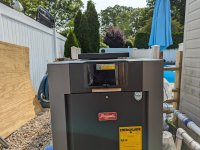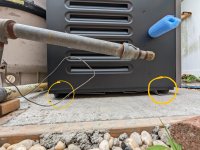- May 4, 2018
- 65
- Pool Size
- 28000
- Surface
- Vinyl
- Chlorine
- Salt Water Generator
- SWG Type
- CircuPool RJ-60 Plus
I bought a new heater and took the opportunity to pour a new concrete pad prior to installing. (Old pad was pieced together plastic bases)
Pad is approximately 6'x3' and I accidentally sloped it too much in the 3 foot direction (total drop of 1" in the 3ft). It's pretty flat in the long dimension.
I'm worried if the equipment (specifically the heater) will be ok installed with that much slope? I took a picture to give a visual sense of the install. I took the pic when the phone indicated it was level so the pic is pretty accurate to what it looks like in person.
Do you think it'll be ok? Should I try to shim the heater to level it out before making final connections?
Id appreciate any thoughts on this.
Thanks
Ron
Pad is approximately 6'x3' and I accidentally sloped it too much in the 3 foot direction (total drop of 1" in the 3ft). It's pretty flat in the long dimension.
I'm worried if the equipment (specifically the heater) will be ok installed with that much slope? I took a picture to give a visual sense of the install. I took the pic when the phone indicated it was level so the pic is pretty accurate to what it looks like in person.
Do you think it'll be ok? Should I try to shim the heater to level it out before making final connections?
Id appreciate any thoughts on this.
Thanks
Ron



